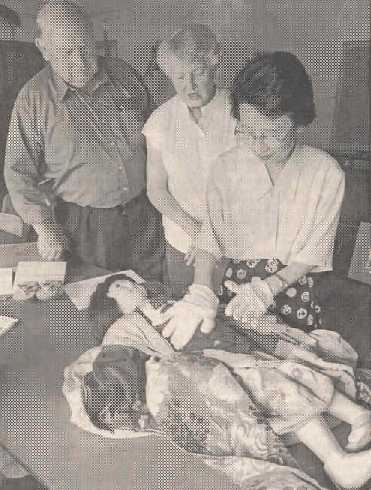City residents help find missing dollJapanese 'Friendship' dolls came to U.S. in 1927 |
|
One day, while reading a Japanese newspaper, the 70-year-old Stewart Street resident came upon a story about a search for Japanese dolls sent to the United States as a gesture of friendship in 1927. He mentioned the story to a neighbor one day while shoveling his sidewalk, and another piece of the puzzle dropped into place. Leda Frank remembered seeing one of the three-foot dolls in a case at the Hartford Children's Museum when she was a little girl. Frank, 77, lived a few blocks away from the museum, and vividly recalled the kimono-clad doll named Miss Chosen, the Japanese name for Korea. Hunter called the museum, which is now the Science Center of Connecticut [name changed back to The Children's Museum in 2006], but no one there knew of the doll or its whereabouts. That prompted Richard Rich, an exhibits manager, to start searching in a basement storage area. There, nestled away in a cardboard box, his assistant, Mike Bonzagni, found Miss Chosen. Hunter and Frank traveled to the West Hartford museum Thursday to meet Michiko Takaoka, an expert on the dolls. As director of the Mukogawa Fort Wright Institute, a Japanese cultural center in Spokane, Wash., she has traveled the country identifying and cataloging the intricately crafted "Friendship" dolls. They were named for Japan's 58 provinces, which at that time included Korea and Taiwan.
Her discovery in January has peaked interest among everyone from Japanese doll aficionados to Sachiko Bible, a Japanese student at CCSU who wrote her senior thesis on the subject. Thursday's gathering at the museum was a celebration of sorts, as Hunter, Frank and a crowd of others thumbed through old booklets and watched Takaoka carefully straighten Miss Chosen's rumpled kimono. Though the flowered silk is faded, Miss Chosen looks remarkably good after 70 years. Her delicate features are modeled after a 5- or 6-year-old Japanese girl, Takaoka said. Her head and limbs are made from a composite of wood chips and glue and connected with strips of cloth. Her bluntly-cut black hair is human. The dolls were sent to the United States in exchange for a gift of some 12,739 blue-eyed dolls sent to Japan by Springfield, Mass., minister Sidney Gulick. Relations between the two countries were growing icy at the time, and he hoped the gift would foster friendship among children and future generations. The dolls came complete with passports, steamer tickets and accessories that included a chest for clothing, sandals and a wooden parasol. "I remember when they made a big thing of her coming," Frank said. "We all knew about it and I remember seeing an exhibit. She was very beautiful, but of course you couldn't touch." Museum officials said they are waiting to see what Miss Chosen needs before deciding what to do next. "We'd like to display her," said Francine Christiansen, spokeswoman for the museum. "It's important to look at our history as we move forward." |
